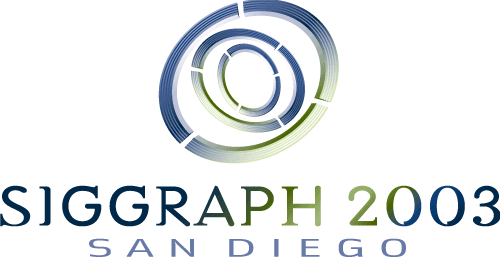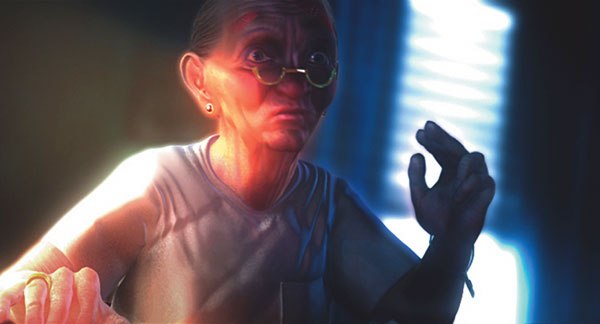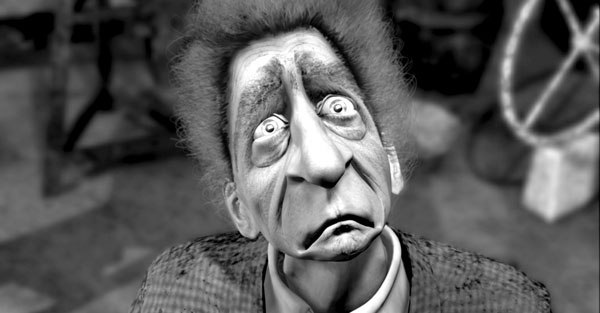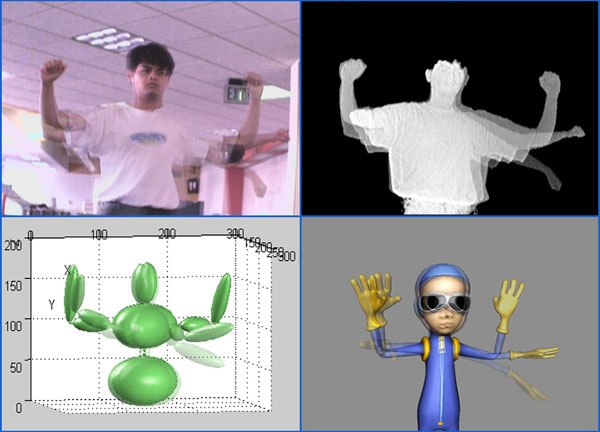Special effects producer Rick Baumgartner traveled to San Diego to check out the new wonders on display at SIGGRAPHs Electronic Theater, and he reports back with what he discovered.
The SIGGRAPH 2003 Electronic Theater presentation started with highlights of the Computer Animation Festival from 10 years ago. After showing selections from the 1993 Festival, a card appeared: Things Have Changed, Right?! followed by the card: Right?! By including both a question mark and an exclamation mark, the festival team wisely left it up to the audience to decide how far the industry has come since 1993 and where it might go over the next 10 years.
According to festival chair Darin Grant (Digital Domain), the festival serves as a mirror of what is possible today and a window into what can be achieved in the future. This translated into 77 selections drawn from 635 submissions. We could do an entire article on festival stats alone (big studios vs. small studios, small teams vs. large teams and so on). For the purpose of this article, however, lets just note two items. First, more than half of the selections came from teams based outside the U.S. Second, student teams affiliated with multi-location digital media schools accounted for about one-quarter of the selections.

Traffik, Show & Tell and Cane Toads were all driven by engaging characters. Traffik © David Bokser. Show & Tell © Kapow Pictures. Cane Toads © Andrew Silke.
In addition to paying respects to the larger U.S. effects studios the festival also celebrated the capabilities of smaller studios, independents (entertainment, educational and scientific) and student teams. The festival exhibited this wide-ranging digital content (full works or excerpts) in two venues the larger offsite Electronic Theater and the smaller onsite Animation Theater. The distinction between the two venues is a subtle one. Per SIGGRAPH:
All [Computer Animation Festival] submissions are juried together and based on identical selection criteria: content, technical implementation, innovation, artistic achievement, production values, creativity, originality, narrative, design, entertainment value and advancement of visualization in the artistic and scientific fields of digital technologies. Entries representing both technical excellence and innovation are more likely to be shown in the Electronic Theater, while entries representing either technical excellence or innovation will be shown in the Animation Theaters.
Themes Like Old Times
Common themes ran through the festival. For example, nearly every selection (including top-notch scientific visualization work) included a strong narrative element. Plucky characters battling adversity (for example: Scrat in the crowd-pleaser Gone Nutty) provided another common thread. Other selections (Traffik, Show & Tell and Cane Toads among them) combined engaging characters and creative storytelling with a gross out factor, complete with blood and gore. These are not your parents animated shorts.
In this article, well take a look at some themes resonating through this years festival:
- Deconstruction using digital tools to examine pre-digital media
- Eyes attention to the look and movement of the eyes of digital characters
- Water emphasis on digital water and fluid dynamics
- Schools strong presence by digital media schools
- Shorts why you should create a short-format project
But before we move to these themes, lets take a quick look at the technical developments presented in the festival
Whats Working Now
The festival selection Industrial Light & Magic R&D incorporated sequences from The Hulk, Terminator 3 and Harry Potter and the Chamber of Secrets and showed advances in creature skin and muscles, skin rendering, motion capture, rigid and deformable dynamics, image-based modeling, digital doubles, fluid and smoke simulation, 3D compositing and cloth simulation. Framestore CFCs Harry Potter selection featured its work on the basilisk creature as well as some effective work on digital feathers. Clips from The Matrix Reloaded explored ESC and EONs virtual cinematography approach and its stunning results. Clips from Daredevil featured Rhythm & Hues work in volumetric effects, notably with the rapidly changing density fields developed for the movies Shadow World sequences. Digital Domains tour-de-force work on Adidas Mechanical Legs used HDRI, high-resolution textures and motion capture to stunning effect. Finally, NVIDIAs Dawn showed the potential of graphics hardware with programmable shading and vertex processing especially in terms of photorealistic skin and hair.
Deconstruction Zone
Several festival selections took apart, explored, and restructured pre-digital media forms. Even the festivals teapot blueprint title sequences sported a retro old film look.
Selections (and the media they deconstructed) included: Ode To Summer (scroll painting), Un Amour Mobile (mobiles, 2D graphics), Puppet Show (marionette theater), Eternal Gaze (sculpture), On The Sunny Side of the Street and Tim Tom (silent black-and-white comedic short films), The Dog Who was a Cat Inside (collage & sketch), Bjorks Nature is Ancient (Oxford Scientific-style educational films) and Empire Of The Eye: Andrea Pozzo (Renaissance architecture).
Supinfocoms Tim Tom, winner of the Jury Honors Award, best represents this theme. Its creators wove a moving story of friendship into a loving yet unsentimental examination of pre-digital media forms sketchpads, flipbooks, kinetoscopes, film frames, theater, sculpture, stop motion, animation, and (yes) audio tracks. Eternal Gaze, judged Best Animated Short, took a more somber, respectful tone as it brought to life the gaunt and haunting work of the late sculptor Alberto Giacometti. Both Tim Tom and Eternal Gaze exhibited in grayscale, paying homage to film as it looked in the first half of the previous century and to films role as incubator for animation, visual effects and scientific visualization.
These works suggest that digital content creators will continue to explore non-digital media forms using digital tools. Of course, its great news for those of us who have always wanted to see what or whom Mona Lisa might have been smiling at. But its also a spur to the industry to envision and create the methods and technologies that will help future practitioners deconstruct and reassemble todays state-of-the-art.
The Eyes Have It
If the eyes are the gateway to the soul, the industry is getting closer to the gate, if not closer to the soul. Bringing up the term photoreal among practitioners can generate more verbal smoke and heat than asking, Whos better Kirk or Picard? at a Star Trek convention. Indeed, many attendees expressed the view that convincing digital doubles (much less all-digital human characters) still have a long way to go. Smaller studios, independents and students are even further behind the majors.
If there is an exception to this, it may be in the eyes. Several festival selections by large and small teams demonstrated increasing facility depicting the "spark of life" in the eyes of their digital characters. Examples of work in this area include: The Lord of the Rings: The Two Towers (Gollum), Exigo (Crow), Eternal Gaze (Giacometti) and Chainsmoker (Old Woman).
Water, Water Everywhere
Fluid simulation methods continue to capture the attention of digital filmmakers. Several festival selections featured results of water and fluid simulation in macro and micro scales. The ILM team even presented a paper on using 2D fluid simulations to create realistic 3D explosions. Examples of convincing photoreal water work in the festival included Gaz De Frances Dolce Vita, Bjorks Nature is Ancient and Johnnie Walkers Fish. Non-photoreal selections featuring water included Early Bloomer and Plumber. Glassworks Bjork music video presented a visually arresting digital portrayal of translucent creatures interacting in an ethereal watery environment. The work had the look and feel of Oxford Scientific microcinematography and shows the industry getting increasingly adept at digitally recreating organic forms.
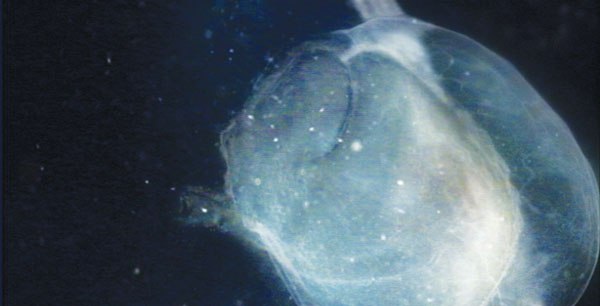
The music video for Bjorks Nature is Ancient boasts photoreal water that rivals Finding Nemo. © Glassworks.
Out of the Mouths of Babes
Several festival selections came from schools of media and design. The festival committee judged these submissions against the same criteria as work the larger studios. The Ringling School of Art and Design, Vancouver Film School, Filmakademie Baden-Wuerttemberg, Savannah College of Art and Design were among the schools represented in the festival. Examples of student work included After You, Mickey's Buddy, Eat Your Peas, Poor Bogo and a twist on the dragons-and-knights clichés, Ritterschlag. The strong current of top-notch digital storytelling coming from schools suggests that these institutions will continue to provide fresh ways to tell stories in the future.

Ritterschlag has been a favorite at festivals around the globe. © Institut of Animation, Visual Effects and Digital Postproduction at Filmakademie Baden-Wuerttemberg.
Do It Now!
Sam Chen, whose Eternal Gaze won the festivals Best Animated Short designation, evangelized digital short-format projects. Even small (in Chens case, two-person) teams can come up with a winner. According to Chen, doing a short film can be an effective way for artists to teach themselves what they need to know. Its about far more than getting a gig. He called the three-year creation process for Eternal Gaze a personal re-appreciation of the fundamentals of space and form. As Chen exhorted in a Meet the Artist session: "The tools are here. Don't wait for the next version of your modeling or animation tool or for the latest renderer. Focus on the art. Do it now!"
Whats Next?
So, what are we going to see in festivals in the near future? Expect to see more photorealistic skin and movement for human characters from smaller shops, independents and students. Expect to see the technologies and methods currently used by the big studios trickle through the rest of the industry. Expect to see more perspectives from international contributors and digital media schools. But also expect to see the unexpected, where upstarts supplant long-time players, where engaging storytelling, unforgettable characters and raw creativity examine the light and dark aspects of life in the 21st century.
This years Computer Animation Festival showed a strong connection to what we saw in SIGGRAPHs Exhibition Hall and Emerging Technologies showcases. Enabling, time-saving technologies such as programmable graphics cards, 3D displays, haptics, fluid simulation software and improved motion capture will help digital artists tell stories. As the cost of these enabling technologies drop, more and more tools will be more available to more people, including students, independents and smaller studios. These tools will allow more digital content creators to spend more time between conception and delivery improving the baby.
The intriguing Emerging Technologies presentations herald a world in which interactive virtual reality systems will play a major role. These technologies will challenge digital storytellers to develop expertise creating interactive experiences. Perhaps in the next 10 years festival attendees will be cheering interactive selections in virtual reality theaters.
So maybe the most important question raised by the festival is not whether times have changed over the last 10 years but, What are YOU going to do to move the industry forward the NEXT 10 years?
Rest assured, the SIGGRAPH Computer Animation Festival will be there to document the best of the best and present it to the world.
Freelance visual effects producer Rick Baumgartner was recently nominated for a 2003 Primetime Emmy Award for his work on Buffy The Vampire Slayer: rick@vfxproducer.com.
